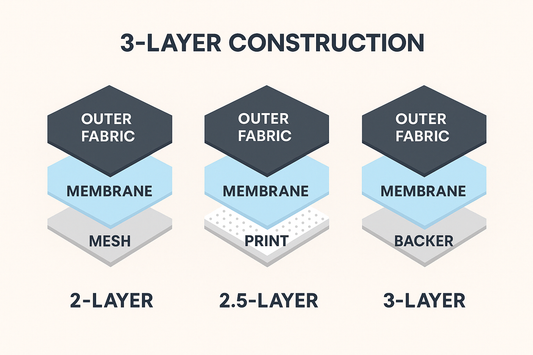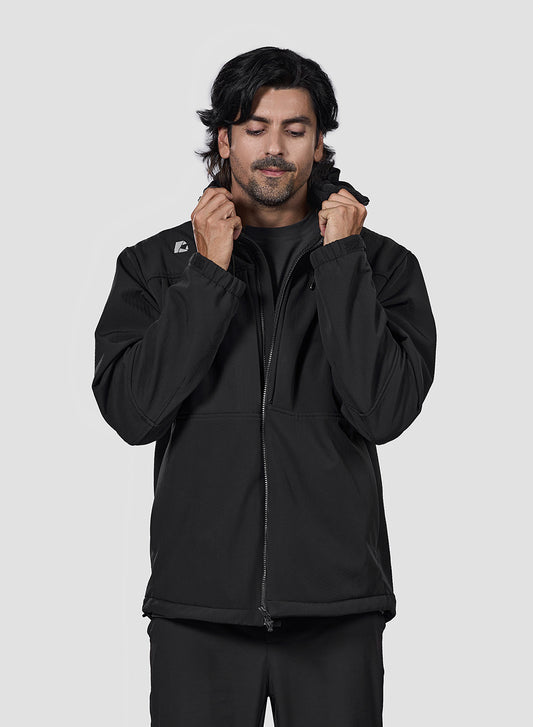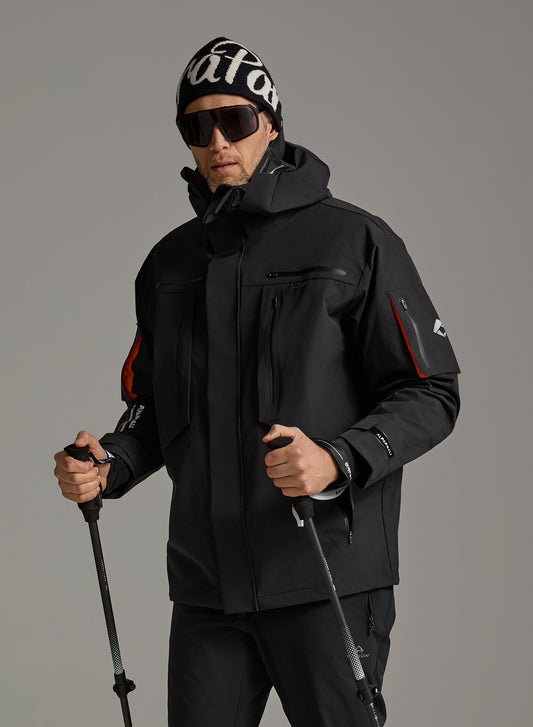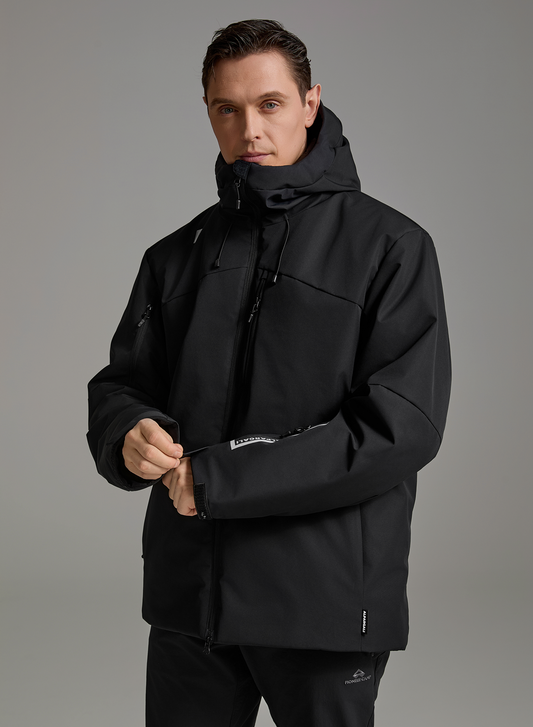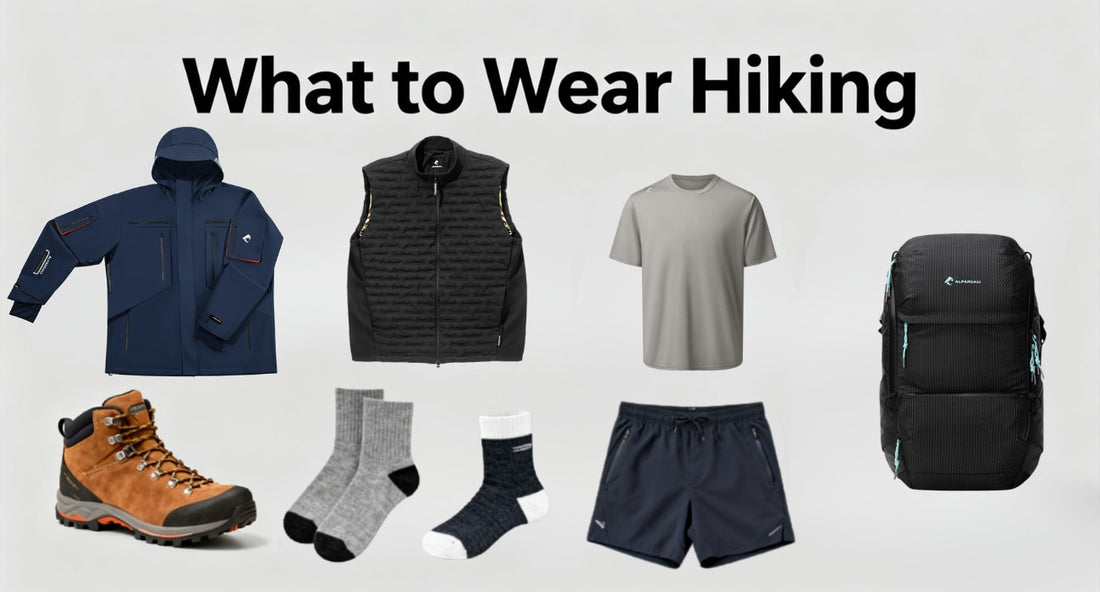
Hiking Clothes for Men: What to Wear Hiking
Share
Hiking is one of those things that’s either a blast or a total pain, depending on your gear. We’ve all seen guys head out with sneakers, a cotton t-shirt, and shorts, thinking it’s no big deal. Trust me, I’ve been there—learned the hard way, too.
This guide is all about getting you prepared for your next adventure. We’ll cover everything from shoes that won’t leave you with blisters to layering tips that’ll keep you comfortable no matter the weather. No confusing tech terms—just straightforward, honest advice to help you make smart choices.
Whether you’re new to hiking or just looking to upgrade your gear, this guide has got you covered. Let’s make sure your next hike is a good one.
Hiking Shoes: What Should I Look for in Hiking Boots or Shoes?

When picking hiking shoes or boots, the key is comfort and fit. Make sure the shoes feel snug in the midfoot, but leave room in the toe box for your toes to move freely. Your shoes should have good traction to prevent slips, especially on rocky or muddy trails. Waterproofing is a must if you’re hiking in wet conditions, but make sure you don’t overheat if it’s a dry day.
Hiking Boots vs. Trail Running Shoes
Hiking Boots: Great for rugged, uneven terrain. They provide support and stability for long-distance hikes and challenging weather.
Trail Running Shoes: Lighter and breathable, perfect for flat or easy trails. They’re great for warm weather but lack the support needed for rocky paths.
Recommended Options:
-
Merrell Moab Series: Durable and supportive, great for longer hikes.
- Hoka Speedgoat: Lightweight and cushioned, ideal for unpredictable trails.
Can Regular Gym Sneakers Work for a Hike?
For short, easy hikes on smooth paths, regular gym sneakers can work, but they’re not ideal. They lack support, have poor traction on uneven terrain, and wear out quicker. For a better experience and safety, investing in proper hiking shoes or boots is worth it. Your feet will thank you!
Hiking Socks: What Type of Socks Should I Wear for Hiking to Avoid Blisters?

Comfortable, moisture-wicking socks are essential for preventing blisters. Look for seamless designs to avoid rubbing, and go for merino wool or synthetic materials to keep your feet dry and odor-free. Make sure the socks are snug but not too tight, as socks that slide down can cause friction.
Recommended Brands:
-
Darn Tough: Known for their durability and comfort, with a lifetime guarantee.
- Smartwool: Soft, breathable, and excellent for long-distance hikes.
Pants & Shorts: Comfort and Flexibility in Your Hiking Choice
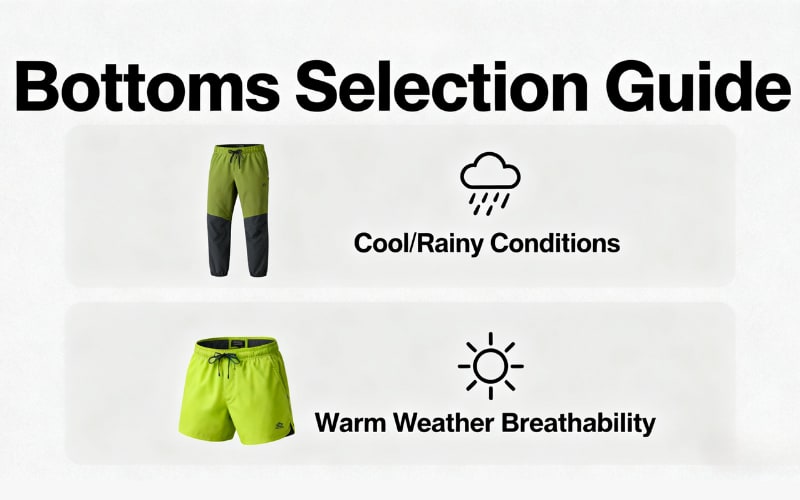
When picking pants or shorts for hiking, comfort and fit are the top priorities. Adjustable waistbands and stretchy fabrics will ensure you can move freely without chafing or discomfort.
Quick-Drying Pants vs. Quick-Drying Shorts
-
Quick-dry pants: Ideal for cooler weather or rainy conditions. They provide full coverage and are great for layering.
- Quick-dry shorts: Perfect for warm weather or longer hikes where you need better breathability and freedom of movement.
Recommended Styles:
-
REI Co-op Trailsmith Pants: Great for almost any terrain, comfortable and durable.
-
Prana Renegade Pants: Flexible, tough, and perfect for longer hikes.
Is It Better to Wear Leggings or Jeans When Hiking?
Leggings are the better option—they’re comfortable, stretchy, and offer full mobility. Jeans are heavy, restrictive, and prone to chafing, making them uncomfortable for hiking. Stick to leggings unless you're on a very short, easy trail.
Is It Better to Hike in Sweatpants or Jeans?
Sweatpants win here. They’re lightweight, stretchy, and far more comfortable than jeans. Jeans are stiff, uncomfortable, and slow to dry. For a more enjoyable hike, go with sweatpants or specialized hiking pants. Avoid jeans altogether!
Base Layer: Stay Dry and Comfortable
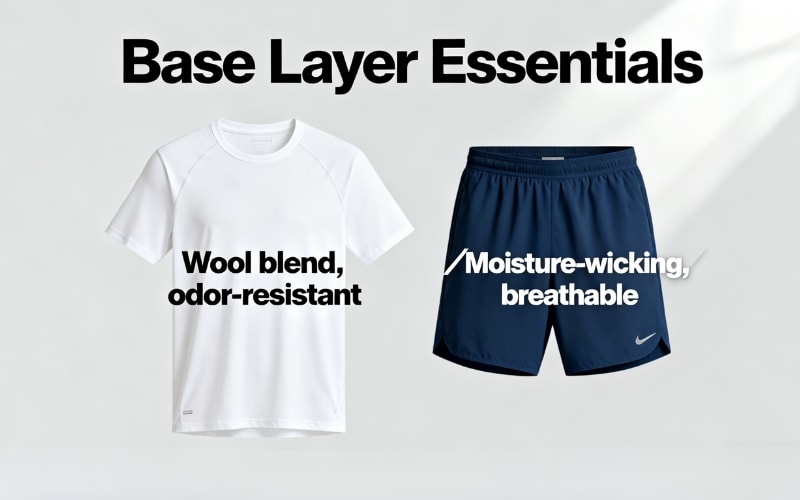
When choosing your base layer, comfort is key. Look for materials that wick moisture away and regulate temperature. Avoid cotton, as it traps moisture, which can lead to discomfort and chills. Opt for synthetic fabrics like polyester or nylon, or merino wool blends for breathability and moisture-wicking properties.
Recommended Styles:
-
Aplargali Nixcore Aerowool Nexus Series T-shirt: A wool blend t-shirt that’s super lightweight, breathable, temperature-regulating, and naturally odor-resistant. Perfect as a base layer, it keeps you comfortable and fresh all day.
- Lululemon Wunder Train High-Waisted Shorts: Ideal for warm weather, offering great moisture-wicking and breathability for active days on the trail.
Mid Layer: Balancing Warmth and Comfort

Your mid layer provides insulation without excess bulk. It should be breathable to allow sweat to evaporate, yet warm enough to retain body heat.
What to Look For:
-
Breathability: Keeps you from overheating.
-
Insulation: Lightweight options for warmth.
- Versatility: Easy to add or remove based on weather or activity.
Recommended Styles:
-
Alparagli Graphene Vest: This is a standout option for maintaining warmth without the bulk. The graphene back panel locks in heat exactly where you need it, and the Sorona insulation offers lightweight warmth. It also features a Teflon-coated exterior, making it water and stain-resistant, perfect for unpredictable weather. The slim design makes it a versatile piece for layering, allowing you to move freely while staying warm.
-
Patagonia R1 Air Fleece Jacket: Ideal for colder weather, this fleece is breathable and warm. It’s perfect for layering, ensuring comfort during intense activity or when you need that extra layer of warmth.
- Autumn Orb Half-Snap Fleece: Lightweight and comfortable, this fleece is perfect for moderate temperatures and seasonal transitions. It’s ideal for layering and staying cozy without being too bulky.
Outer Layer: Protection Against the Elements

The outer layer protects against rain, wind, and snow. It should be breathable, waterproof, and allow free movement, especially on rugged terrain.
Recommended Styles:
-
Alpargali Men’s All-Weather Outdoor Jacket: This jacket is an absolute standout for year-round versatility. With 14 waterproof pockets and 15K breathability, it offers incredible storage and weather protection without sacrificing comfort. Whether you're hiking in the mountains or heading into the city, this jacket has it all, including a waterproof wind stopper, underarm vents, and a high neck for additional wind protection. It's the perfect blend of style and functionality, adaptable to any environment you find yourself in.
-
Arc'teryx Beta SL Rain Jacket: Known for its lightweight and waterproof performance, this jacket is perfect for sudden rain or snow. It’s designed for hikers who need reliable protection in unpredictable weather. The GORE-TEX fabric offers superior water resistance while allowing moisture to escape, keeping you dry and comfortable throughout your hike.
-
REI Co-op Trailmade Rain Pants: Ideal for wet conditions, these pants are both waterproof and comfortable. They’re easy to pack away and wear, offering great protection against rain without adding too much weight to your gear.
Backpack: Choosing the Right Hiking Backpack
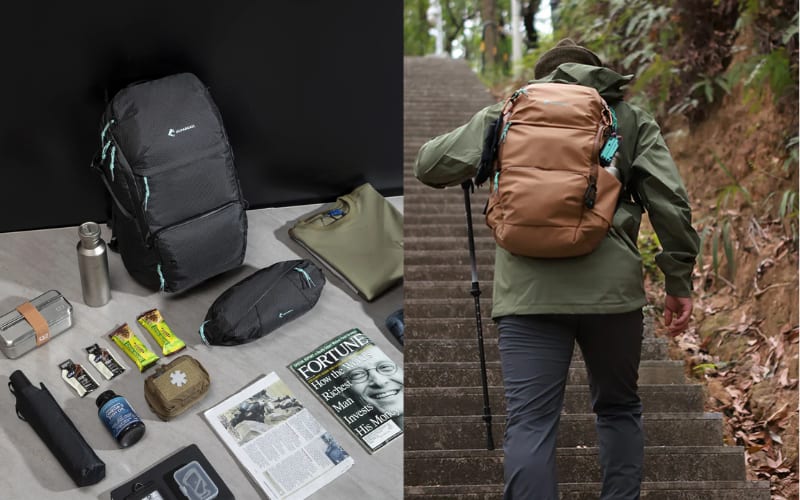
Choosing the right backpack is essential for comfort and function. Whether it's a short day hike or a multi-day trek, your backpack should match the length of your hike and the amount of gear you need to carry.
What to Look For:
-
Backpack Size: Smaller (20L-30L) for short hikes; larger (40L-70L) for extended trips.
-
Comfort: Look for padded straps and an adjustable hip belt for even weight distribution.
- Access: Easy-to-use compartments for quick access to gear.
Recommended Styles:
-
Alpargali All-Day Backpack (22L): Perfect for short hikes and everyday use, this backpack features over 15 compartments, a waterproof design, and a clamshell opening for easy organization. The Ergonomic 3-zone load distribution reduces shoulder strain, making it incredibly comfortable for day-long adventures. Plus, with a 22L capacity, it’s ideal for carrying your essentials without being too bulky.
-
Osprey Skimmer 20: ightweight and durable, this 20L pack is perfect for short treks, featuring breathable mesh shoulder straps and an adjustable sternum strap for added comfort.
- Gregory Juno Backpack: Designed for longer hikes, this pack offers an adjustable harness and hip belt to evenly distribute weight, ensuring comfort on multi-day treks or with heavy loads.
Choosing the right backpack comes down to the duration and complexity of your hike, but these recommendations cover a variety of options to suit your specific needs.
What Kind of Clothing is Best for Hiking?

When choosing clothing for hiking, comfort, durability, and weather protection are key. You'll want fabrics that wick moisture away from your skin, are breathable, and can handle changing conditions. Here’s what to focus on:
-
Moisture-Wicking: Opt for fabrics that pull sweat away from your skin, keeping you dry and preventing chafing.
-
Breathable: Ensure your clothes allow airflow to prevent overheating during intense activity.
-
Quick-Drying: Choose materials that dry quickly when wet, so you stay warm even in unpredictable weather.
What Are the Different Types of Hiking Jackets?
Hiking jackets are designed to handle specific weather conditions. Here’s a breakdown:
-
Windbreakers: Lightweight and compact, perfect for mild conditions. They block wind without adding bulk.
-
Rain Jackets: Waterproof and breathable, designed to protect you from rain while allowing sweat to escape. Essential for unpredictable weather.
-
Insulated Jackets: Perfect for colder temperatures or high-altitude hikes. These keep you warm with either down or synthetic insulation.
Each jacket serves a unique purpose. Pick the right one based on your hike’s climate and conditions.
What is the Best Material for Hiking Clothes?
The best materials for hiking are synthetics (like polyester and nylon) and merino wool. Both are lightweight, moisture-wicking, and durable. Here's the difference:
-
Synthetics: Affordable, fast-drying, and tough. Ideal for base layers, mid-layers, and outer layers.
-
Merino Wool: Naturally odor-resistant and temperature-regulating. It’s a great choice for base layers and socks, but can be more expensive and slower to dry than synthetics.
Why is Cotton Bad for Hiking?
Cotton is not suitable for hiking because it traps moisture and takes a long time to dry. When cotton gets wet, it stays wet and draws heat away from your body, which can lead to discomfort and increase the risk of hypothermia. Stick to synthetics or wool for better performance.
Is Polyester Good for Hiking?
Yes, polyester is a great choice for hiking. It’s lightweight, breathable, and quick-drying, making it perfect for active wear. It also performs well in various weather conditions, which is why it’s often used in base layers, mid-layers, and jackets.
Is Fleece Good for Hiking?
Fleece is a solid option for hiking because it’s warm, breathable, and lightweight. However, fleece isn’t waterproof, so it works best as a mid-layer. Our Alpargali Coreshell Jacket takes it a step further, combining fleece with a waterproof, windproof outer shell for superior performance in tough conditions.
Is Wool or Synthetic Fabric Better for Hiking Clothes?
Both materials have their advantages:
-
Wool (especially merino wool) is great for moisture-wicking, odor-resistance, and temperature regulation. It's perfect for base layers and socks, but it tends to be more expensive and doesn’t dry as quickly as synthetics.
-
Synthetic Fabrics like polyester and nylon are cheaper, dry faster, and are generally more durable. They’re excellent for active wear and outer layers.
Pro Tip: Many seasoned hikers use a combination of both, like in the Alpargali Coreshell Jacket, which combines durable stretch nylon, high-performance TPU film, and jacquard fleece lining. It’s waterproof, windproof, and breathable — ideal for all weather conditions.
What Should I Wear on a Hike as a Beginner?
If you're just starting, keep it simple and focus on comfort:
-
Base Layer: Choose a moisture-wicking synthetic or merino wool shirt.
-
Pants/Shorts: Go for something lightweight and quick-drying.
-
Footwear: Hiking boots or trail shoes for support.
-
Outer Layer: Bring a light jacket or windbreaker to protect against changing weather.
-
Accessories: Don’t forget a hat, sunscreen, and sunglasses for sun protection.
Avoid cotton at all costs, as it traps moisture and can make your hike uncomfortable. Stick to these basics, and you’ll be all set for your first hike.
Gear for Hiking in Different Environments and Weather

What to Wear When Hiking in Summer
In hot weather, your goal is to stay cool while protecting yourself from the sun. Lightweight, breathable clothing is key, and gear with UV protection will help shield your skin.
-
OR Astroman Air Sun Shirt: Breathable, lightweight, and UV protective, perfect for high temperatures.
-
Columbia Omni-Freeze Series: Sweat-activated cooling technology keeps you dry and cool in the heat.
Look for gear with UPF protection to prevent sunburn, especially during midday hikes.
What to Wear When Hiking in Winter
Winter hikes require clothing that keeps you warm but also offers breathability. Layering is crucial, and high-quality insulation will keep you warm without bulk.
-
Alpargali Aerogel Graphene Puffer Jacket: Featuring advanced materials like graphene and aerogel, this jacket provides excellent warmth for temperatures between -40°C/-40°F and +10°C/50°F, without the bulk. It also offers 10K waterproof protection, making it perfect for unpredictable winter weather.
-
Patagonia Nano Puff Jacket: Lightweight yet warm, this jacket is a great option for colder environments where you need warmth without feeling weighed down.
-
REI Co-op Magma Down Hoodie: This down hoodie is perfect for extremely cold conditions, providing excellent insulation and warmth.
In winter, choose warm, lightweight, and packable layers for easy adjustments.
Snow and Rain Weather: Waterproof and Anti-Slip Gear
Hiking in snowy or rainy conditions, you’ll need gear that keeps you dry and provides stability on slippery surfaces. A good combination of waterproof clothing and anti-slip accessories is essential for safety and comfort.
-
Kahtoola Microspikes: These are perfect for ice and snow, offering increased stability and traction to prevent slipping on icy surfaces.
-
Salomon Quest Waterproof Hiking Boots: Designed for wet and slippery conditions, these boots are waterproof, breathable, and offer excellent grip.
Can I Use Regular Gym Clothes for Hiking in Warm Weather?
For short hikes, regular gym clothes can work if they’re breathable, but for longer hikes, it's best to invest in hiking-specific gear designed for moisture-wicking and UV protection.
What to Wear Hiking in 50-Degree Weather
For temperatures around 50°F (10°C), you’ll need clothes that can easily adjust to temperature changes. Lightweight layers are key, and having the option to add or remove layers will help you stay comfortable as the day progresses.
-
Light Fleece or Thin Down Jacket: Wear a breathable long-sleeve shirt or light fleece for the daytime, and layer on a thin down jacket as temperatures drop in the evening.
-
Quick-Dry Pants: Pants that dry quickly and offer breathability are important for moderate temperatures, as they will keep you comfortable and dry.
How Should I Pack for a Hike in Cold Weather or Unpredictable Conditions?
Layering and extra gear are crucial in cold or unpredictable conditions. Here's what to pack:
-
Base Layer: Moisture-wicking materials like polyester or merino wool will keep you dry.
-
Mid-Layer: Fleece or down jackets for insulation.
-
Outer Layer: Waterproof jacket and pants to protect from rain and wind.
Always bring extra layers to adjust to changing weather.
What Additional Layers or Accessories Should I Pack for Hiking in Cooler Temperatures?
In cooler temperatures, pack layers and accessories to stay warm and comfortable:
-
Hat and Gloves: Wool or synthetic hats and gloves for warmth.
-
Scarf or Neck Gaiter: Protect your neck and face from cold winds.
-
Thermal Socks: Wool or synthetic socks for added warmth.
-
Hand Warmers: Keep your hands warm during breaks or long hikes.
Layer appropriately and always have the flexibility to adjust your gear as needed.
About Layering: What is the 3-Layer Rule for Hiking?
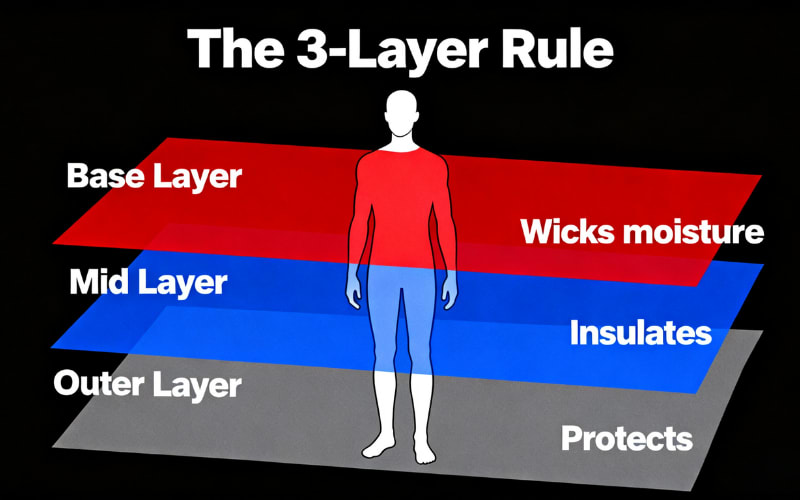
The 3-layer rule is a simple system for staying comfortable while hiking, adapting to different weather conditions. It consists of:
-
Base Layer (First Layer) – Wicks moisture away from your skin.
-
Mid-Layer – Provides insulation to keep you warm.
-
Outer Layer – Protects you from the elements (wind, rain, snow).
This system helps you adjust based on the weather and activity level.
What is the Best First Layer for Hiking?
The first layer should be moisture-wicking to keep you dry. Avoid cotton, as it traps moisture. Opt for merino wool for breathability and odor resistance or synthetic fabrics for affordability and quick drying. Look for long-sleeve shirts or lightweight base layers for sun protection.
What are Common Layering Mistakes?
Common layering mistakes include:
-
Over-layering: Wearing too many layers causes overheating and excessive sweating.
-
Under-layering: Not enough insulation can leave you cold.
-
Using cotton: It traps moisture, causing discomfort and chills.
-
Not adjusting layers: Failing to add or remove layers based on activity leads to discomfort.
What is the Best Way to Layer Clothing for a Hike in Different Weather Conditions?
-
Warm Weather: Choose a moisture-wicking base layer (short-sleeve or tank top), lightweight pants or shorts, and a breathable outer layer like a windbreaker.
-
Cold Weather: Use a thermal base layer, fleece or down jacket mid-layer, and a waterproof jacket as the outer layer.
-
Rainy Weather: Start with a moisture-wicking base layer, add a warm mid-layer, and finish with a waterproof shell to keep dry and comfortable.
Layering gives flexibility to adapt to changing conditions, keeping you comfortable no matter the weather.
Hiking Gear & Accessories
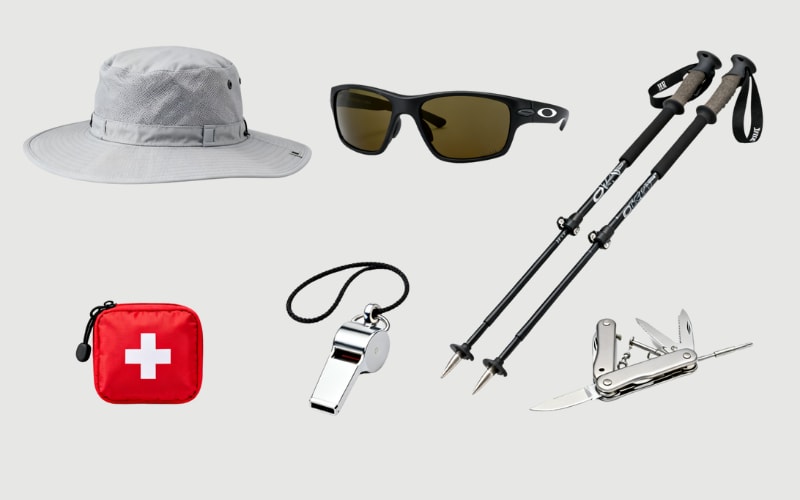
Having the right gear and accessories can make a big difference when you're on the trail.
Head Protection: Hats and Sunglasses
Choosing the right hat and sunglasses is crucial for protecting your head and eyes during your hike. A good hat will shield you from the sun, while quality sunglasses will help protect your eyes from harmful UV rays and glare. Here are a few recommendations:
-
REI Co-op Active Pursuits Sun Hat: This hat provides excellent sun protection and is made with breathable materials, ensuring comfort during long hikes in hot weather. It’s lightweight and adjusts to fit your head, making it perfect for extended use.
-
Oakley UV Protection Sunglasses: These sunglasses are designed to block 100% of harmful UV rays, protecting your eyes from the sun's harmful effects. The durable design also ensures they stay in place, even on the most rugged trails.
Trekking Poles: Enhance Stability and Comfort
Trekking poles are essential for maintaining balance, especially on uneven terrain, and they can reduce the strain on your knees during descents. If you’re planning a long hike, they become invaluable tools for stability and comfort.
-
Black Diamond Alpine Carbon Trekking Poles: These poles are lightweight yet durable, providing excellent support on both uphill and downhill sections. They’re designed for long hikes, offering a comfortable grip and the ability to adjust easily to your preferred height.
First Aid & Safety Gear
No matter how prepared you are, it’s always smart to carry some basic first aid and safety equipment when hiking. This includes essential items like a first aid kit, whistle, and multi-tool. Whether it’s for minor cuts or more serious injuries, having these items on hand ensures you’re ready for the unexpected.
-
First Aid Kit: Make sure your kit includes essentials like bandages, antiseptic wipes, blister treatment, and pain relievers.
-
Whistle: A whistle can be used to signal for help in case of an emergency, especially in areas where phone service might be weak.
- Multi-tool: A Swiss Army knife or Leatherman is handy for any repairs or tasks you may encounter on the trail.
Ready for Your Next Adventure?
Choosing the right hiking gear is key to a comfortable and enjoyable outdoor experience. With the right clothing, shoes, and accessories, you’ll be prepared for anything the trail throws at you.
At Alpargali, we specialize in premium gear that combines durability, comfort, and functionality. From performance-driven jackets to versatile backpacks, we offer everything you need to make your hiking experience seamless.
Want to take your hiking game to the next level? Visit our Hiking Guide Page for expert tips and explore our full collection of outdoor gear. Whether you’re just starting out or are an experienced hiker, we’ve got you covered.
Get ready for your next adventure with Alpargali—the ultimate outdoor companion.

